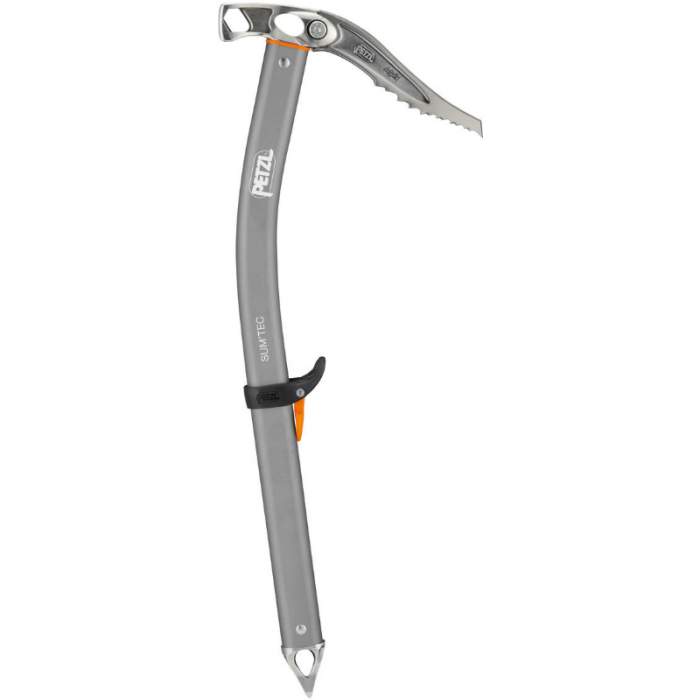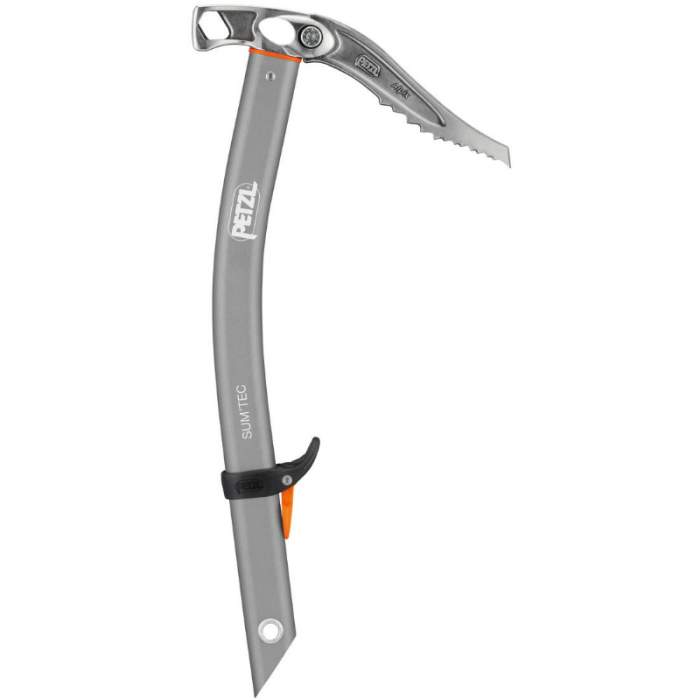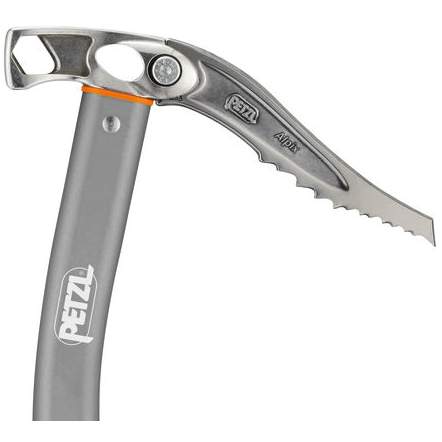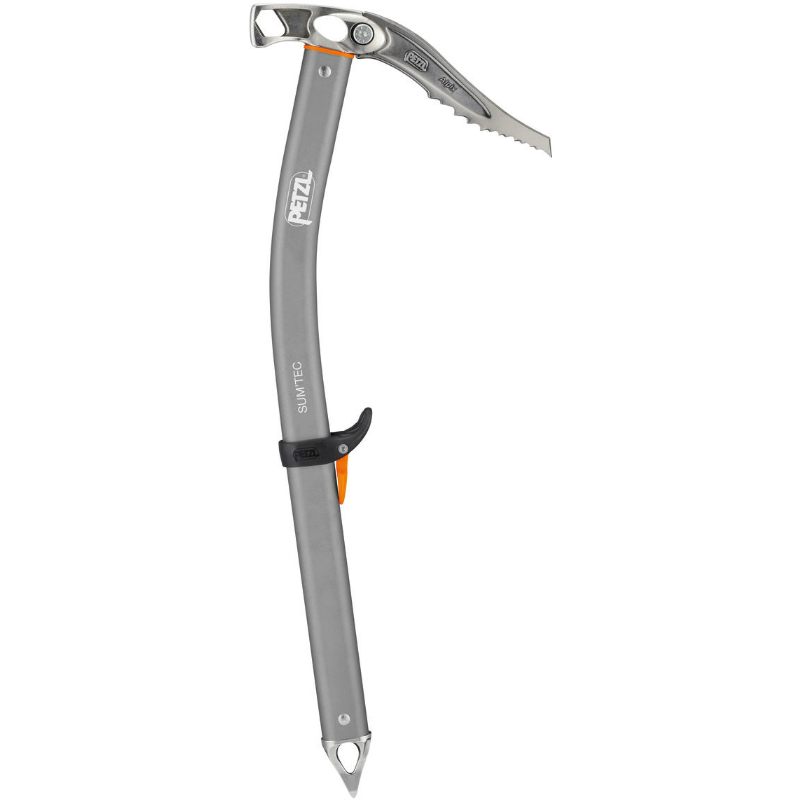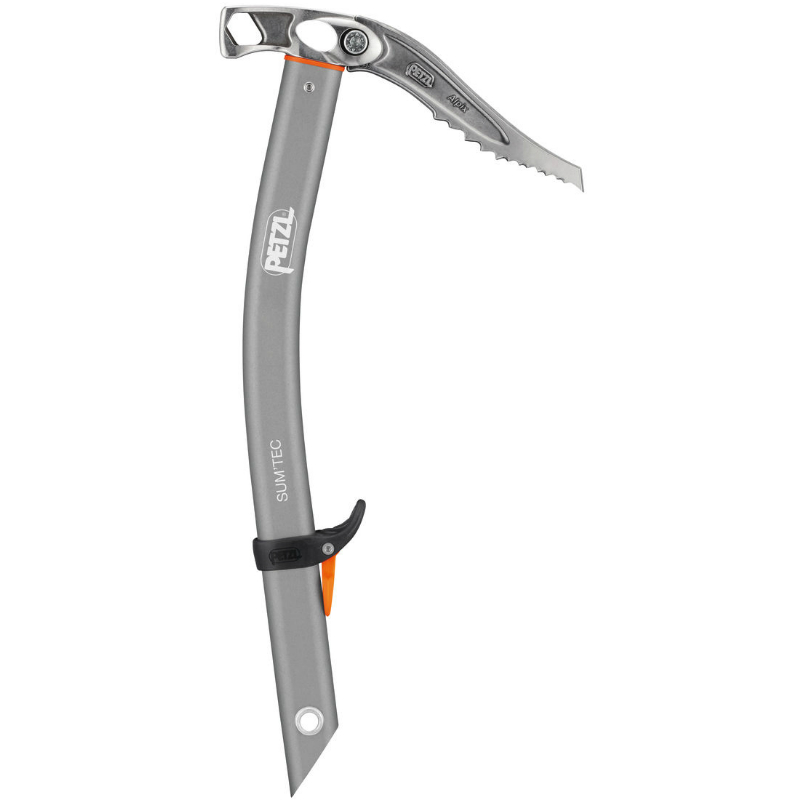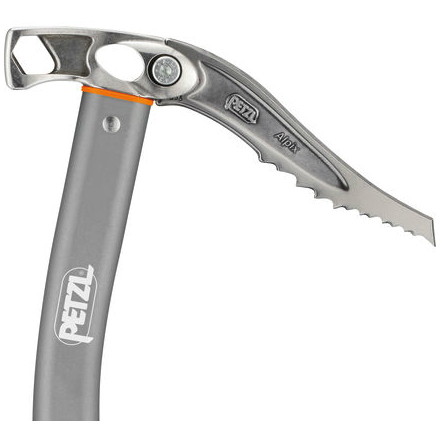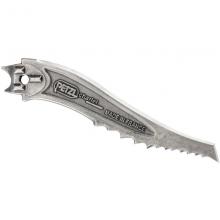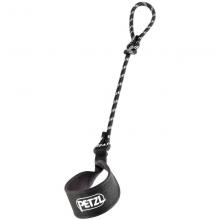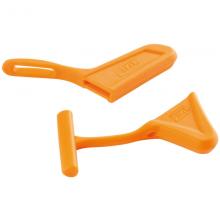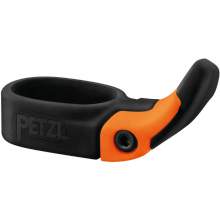Sum'tec Hammer 2017
Description
Lightweight ice axe for technical mountaineering.
A compromise between a classic mountaineering ice axe and an ice climbing axe, the SUM’TEC is a versatile, lightweight, technical ice axe. It is easy to use in piolet-canne mode with its stainless steel spike and its slightly curved shaft. In piolet-traction, the ALPIX pick (forged into banana shape) and the new TRIGREST hand rest (adjustable without tools) ensure the efficiency required for technical passages, as well as bergschrunds, ice gullies... Available in adze or hammer versions.
Description
Lightweight technical ice axe, effective in piolet-traction or piolet-canne mode.
New version of the TRIGREST allows multiple hand grip possibilities, thanks to the simple, tool-free manual adjustment system.
The thin ALPIX pick (3.5 mm) is designed for effective penetration into ice. It is quickly and securely replaced with a unique screw lock system.
Stainless steel spike ensures excellent grip on rock.
Lightly curved handle protects the hand when climbing.
Available in adze or hammer versions:
- SUM’TEC adze version for efficient cleaning of snow and ice. Available in 52 and 59 cm shaft lengths
- SUM’TEC hammer version for easy piton placement. Hammer is now lighter and features keys for tightening bolts of 8 to 10 mm. Available in 43 and 52 cm
Wide oval holes in the head and in the spike to facilitate clipping a carabiner.
Retail price
This Product is Hard to Find.
We don’t know where you can buy this item online in the US. We’ll continue to check all the major retailers and will update this page as soon as we find one.
If you know where to find this online in the US, let us know, and we’ll add the link.


Weight (g / oz)  Weight (g / oz)In grams and ounces, the weight, as stated by the manufacturer/brand. Since the most common ice axe length is 50cm that is the main length that we reference. When available, we list the weight for each length here. | 495 g / 17.46 oz 43 cm: 430 g / 17.11 oz |
Best Use  Best UseUltralight MountaineeringThe lightest axes available, used most for ski mountaineering, adventure racing, and other "go light" ascents. 350 grams is usually the max weight. The decreased weight means they are axes are built for snow missions, not ice. MountaineeringThis is the most common type of snow mountaineering axe. These axes are above 350 grams and are a great balance of weight and durability. There may be a grip and they will always have an adze head (and no matching hammer pair). These axes are great for snow and can handle chopping steps in ice, or other small ice scenarios. Technical MountaineeringThese axes are for tougher conditions when the majority of climbing is on snow, but the axe needs to be able to handle a short ice wall. They generally have a bent shaft and T-rated (more technical) pick. Often these beefier axes will have a rubberized grip and they may have a matching adze and hammer version. They're basically the offspring of an ice axe and ice tool. |
Technical Mountaineering |
Length Options (cm)  Length Options (cm)Measured in centimeters, the best length is based on your height and ape index (arm length). Holding the axe in your hand, the spike (sharp end) of the axe should arrive around your shin. At the max size, it should go to your ankle. Two people of the same height could need a different sized axe, based on arm length (t-rex vs monkey). If in-between sizes, our bias is towards sizing shorter. Rule of Thumb
Worth ConsideringThere are other resources online that suggest a longer axe is a plus and that you should measure below the ankle. We absolutely disagree. A longer axe means you'll be tempted to use it as a trekking pole (which will put you off balance), or you'll have to give your arm a huge workout just to lift it in and out of the snow. Ice axes are meant to be used on the uphill side, which is already much higher. |
43 cm, 52 cm |
Head Details  Head DetailsThis refers to the back of the ice axe head (opposite the pick). 
For ice axes, adze's are (by far) the most common. An adze will allow you to break ice by chopping or shoveling in a specific area, and they also provide more room to hold on to the head than a hammer does. This grip helps for arresting too. Hammers are usually only used as a pair with an adze on the other axe (hammer's are much more common in ice tools than ice axes). A hammer uses a more broad force to break ice bulges. | Hammer Pair axe: Sum'tec Adze 2017 |
Ice Rating  Ice RatingThe certified rating of the pick and the shaft. These ratings might not match each other. There are only 2 possible shaft ratings: B / Type 1 / CEN-B: Basic | Pick: B / Type 1 Shaft: T / Type 2 |
Materials  MaterialsThe materials, as stated by the manufacturer / brand, of the pick, head, shaft and grip. | Pick: Forged Steel Head: Forged Steel |
Certification  CertificationsThe main climbing gear certifications are CE and UIAA--and normally the UIAA creates the rules that the CE body also supports. When possible, we try to list all the certifications the product carries. To sell a climbing product in Europe, the device must be CE certified. There are no official requirements to sell climbing gear in the US. The UIAA certification is a voluntary process. For ice axes, there is a separate certification for the pick and the shaft. Learn MoreRock and Ice Certifications Guide |
CE, UIAA |
Warranty  WarrantyThis isn't super common, but sometimes the manufacturers will state a specific warranty such as "3 years against manufacturer defects" |
3 years against manufacturer defects |
No reviews yet.
The Sum’tec is an alpine work horse that excels in modern mountaineering and alpine climbing. Do you want to get out and cross glaciers, climb snow, ice and rock and really need a tool that will be there for you in every condition? Or, maybe you need one great tool that will do everything needed for that summer mountaineering trip or course? Either way, the Sum’tec is the way to go.
In conclusion, the Petzl Sum’Tec is an awesome choice as the terrain gets steeper and becomes more technical. Its sweet spot is really on those long, moderately steep routes or carried as a tool for piton placement on alpine routes, but still has its place on more moderate escapades.
The Sum’Tec is a bit of a mixed bag for me. It performs excellently and it inspires confidence on most terrain. I grab it without hesitation on all of my ski mountaineering projects. However, in the back of my mind there is this nagging voice saying, This could be better. Unless you are confident that you won’t ever need to buy a technical ice tool, I have a hard time recommending the Sum’Tec. Even though it performs exactly as advertised and I have been quite happy with it, I think there are better options out there for most people.
The Sum'Tec is offered with either an adze or a hammer, with various shaft lengths: 52 cm for the hammer version and 52 or 59 cm for the adze version. Each features a 3.5 mm "B"-rated pick connected to a "T"-rated, slightly curved aluminum shaft. A quick click of the Trigrest allows it to slide from technical tool positioning up the shaft to the head, such that the spike can be used as an effective balance point in piolet-canne position. The spike also features an ample hole that easily accepts tethers. I prefer pairing the 52 cm hammer with the 59 cm adze to tackle technical-but-lower-angle alpine ice objectives like the icy prow of Mt. Baker's North Ridge and mixed terrain on the Aiguille du Chardonnet in the French Alps.
If you know of a good product video that should be here, let us know, and we'll put it up.
If you're looking for gear videos in general, check out our Vimeo and YouTube channels to see the newest gear.

